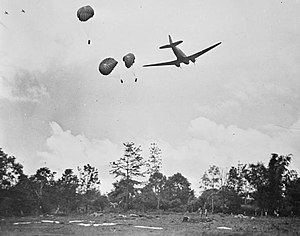
Back বার্মা অভিযান ১৯৪৪ Bengali/Bangla Burma-Kampagne 1944 German لشکرکشی برمه (۱۹۴۴) Persian Opérations en Birmanie en 1944 French Burma japán megszállás alatt (1943–1944) Hungarian Kampanye Burma (1944) ID Бирманская операция (1944) Russian การทัพพม่า (ค.ศ. 1944) Thai
| Burma Campaign 1943–1944 | |||||||
|---|---|---|---|---|---|---|---|
| Part of the Burma campaign, the South-East Asian theatre of World War II, the Second Sino-Japanese War and the Pacific Theater of World War II | |||||||
 A C-47 transport aircraft drops supplies by parachute to Allied troops in action against Japanese forces; a common event during the fighting in Burma and India during 1944. | |||||||
| |||||||
| Belligerents | |||||||
|
| |||||||
| Commanders and leaders | |||||||
| Casualties and losses | |||||||
| 29,324 (British Commonwealth) | 71,289 (Japanese)[2] | ||||||
The fighting in the Burma campaign in 1944 was among the most severe in the South-East Asian Theatre of World War II. It took place along the borders between Burma and India, and Burma and China, and involved the British Commonwealth, Chinese and United States forces, against the forces of Imperial Japan and the Indian National Army. British Commonwealth land forces were drawn primarily from the United Kingdom, British India and Africa.
The Allies had overcome the logistic and organisational difficulties which had crippled their earlier efforts, and they were preparing to invade Japanese-occupied Burma at several widely separated points. The Japanese forestalled them by launching their own offensive into India, and this offensive became larger in scope than originally intended. By the end of the year, the Allies had achieved significant territorial gains only in one sector, the extreme north-east of Burma, but the Japanese attack on India had been defeated with very heavy casualties. This handicapped the Japanese attempts to defend Burma against renewed Allied offensives in the following year.
- ^ The Burma Boy, Al Jazeera Documentary, Barnaby Phillips follows the life of one of the forgotten heroes of World War II, Al Jazeera Correspondent Last Modified: 22 July 2012 07:21,
- ^ not counting casualties fighting against Chinese / American forces